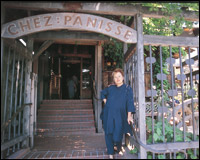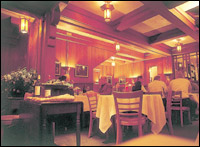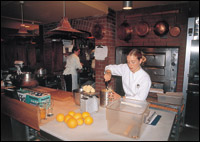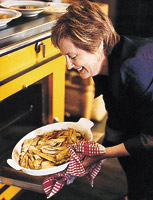


 Grande Dame Of California
Grande Dame Of CaliforniaALICE WATERS has shown an America raised on meatloaf that fresh, nourishing food, organically grown and simply prepared, ranks up there next to godliness. Bombay restaurateur and chef RAHUL AKERKAR wined and dined with her at her California restaurant Chez Panisse. |
|
THIS is only my third meal at Chez Panisse over the past several years. I try and eat there at least once whenever I visit San Francisco. Everyone should. Tonight I�m dining in their downstairs dining room with John Locke, one of the winemakers of the eclectic Bonney Doon winery in Santa Cruz. John used to be the winemaker with Chateau Indage in Narayangaon a few years ago, which is how I met him. I�m in good hands tonight: Chez Panisse is doing the food, John�s agreed to choose the wines, and MasterCard pays for it all... OK, so it�s my MasterCard... the evening will definitely be one I won�t forget!
It�s the middle of the week, they�re serving a set three-course menu and dessert. They do a five-course menu on the weekends. Tonight, the menu is an asparagus and spring onion tart with beets and garden lettuces, followed by Northern halibut and clams with saffron and wild fennel. The main course is a spit-roasted Niman Ranch rib eye with morels, crispy potato cake; pea and fava bean ragout; the dessert, a Hazelnut ice-cream and espresso granita coppa. We tear pieces of wonderfully fresh and crusty peasant bread and pop marinated olives in our mouths. This is the avant gout, the taste of things to come, the primer. We look at their rather exhaustive wine list. John�s eyes light up; he�s spotted a couple of wines that are allocated only to Chez Panisse. �Can�t get these anywhere else, which one should we get?��Sounds good to me, let�s get them both,� replies MasterCard!
We start with what is truly a magnificent Sauvignon Blanc, a Didier D�Ageneau Pouilly Fume En Chaillion 1999 with our first two courses. I�m amazed at what pours out of the bottle with the rather un-embellished, white, handwritten label. The other wine, a big Syrah that John selects for our rib eye is 1998 St. Joseph-Recolte Domaine J.L. Chave. I can�t wait to see how this Rhone wine from near Hermitage will shape up. I tease John about selecting French wines in California. He chuckles and suggests I shut up and enjoy the wine instead... I can�t argue with that!
We settle in and catch up with the two years that�s passed us by. Tucking into each course, I realise why I, like so many others, make it a point to eat at Chez Panisse. 8Everything tastes better here. The vegetables are fresher, the herbs burst with flavour. Each dish is well thought out, cooked to perfection and supremely balanced. There are no frivolous or arcane combination of ingredients, no architectural, sensationally presented constructs, nothing that shouldn�t be there on your plate. The dishes are simple, robust and hearty; the best, freshest, seasonal organic ingredients, cooked to perfection. Nothing more. It�s what food and eating should be �magic in its essence, devoid of attitude and ego.
A few weeks later I drive back to Berkeley at lunchtime. The upstairs cafe at Chez Panisse is buzzing. Opened in 1980 with an open kitchen, a wood-burning pizza oven, and an a la carte m8enu, the cafe was a natural extension to the set menu dining room downstairs, which is closed for lunch. The open kitchen is busy, and I notice everyone�s going about their work, readying for dinner with the calm efficiency of a well-oiled team. One of the cooks stops cleaning Jerusalem artichokes piled high on a table in the dining room to welcome me. Alice is in a meeting and will be by shortly. I wait at a table near a window overlooking sunny Shattuck Avenue and watch the cooks. I remember my days in New York restaurants...
Alice walks through the kitchen, exchanges a few words with her cooks and comes by. Not the Grande Dame vision of California Cuisine I imagined; she�s warm, accessible, immediately friendly, almost motherly, and best of all, her eyes sparkle! We talk at length about culinary philosophy, food and such and she�s very interested in me, my background, and what we�re doing at Indigo. I�m flattered!
RAHUL: Has it been easy doing Chez Panisse all these years - following the same basic formula of serving only the highest quality locally grown organic products, only when they are in season? Obviously it�s worked, looking at how busy you are.
ALICE: Easy... no! It�s been very difficult getting our customers to truly appreciate and cherish what we do here. Not everyone understands the need for organic food... we�ve had to educate a lot of people.
RAHUL: I�m surprised. Surely in health conscious US,
and especially in California � the market basket of the world � there must exist a great knowledge of the benefits of organic produce.
ALICE: You�d be surprised! Yes, there are those are very aware, and much more so today � over the past few years � but it�s been a long journey convincing people of the need to eat seasonally and locally grown produce. Most people know this, but very few truly live it. Food is alive. Good ingredients are active, not static and people need to be reminded that�s its always been this way. You went to the market, saw what was available, went home and cooked a meal. Everything was fresh, correct for that time of year... and probably cost less too, because it was seasonal and locally grown.
RAHUL: This is, in a sense, the basis of the Slow Food Movement isn�t it? I understand you�re very involved with it.
ALICE: Yes, it is. I head the California Convivium (chapter) of the movement. It�s a connection to what food should be.
RAHUL: Tell me about your Edible Schoolyard programme. I assume it�s an offshoot of your involvement with Slow Food.
ALICE: Yes, it�s very important to me. Several years ago I set up The Edible Schoolyard program at the Martin Luther King Jr. Middle School, not far from here. They had an abandoned cafetaria and garden and I really wanted the kids to understand the relationship of the earth to the table. The program is simple, it involves the kids in planting, gardening, harvesting, cooking and eating together. Kids don�t understand the relationship of food to culture and food to agriculture. That�s what we�re trying to teach. They need to understand how to take care of the land, how to cook, how to feed themselves and how to communicate at the table because that�s where our culture is passed on. The choices that you make about food affect the quality of your life and also the future of the planet. Food brings people together. There�s something about the purity of preparing it, offering it, and sharing it. It�s an expression of love.
RAHUL: So, where do you source your produce? Is it all organic?
ALICE: It�s taken a while, but we have a strong (and growing) vendor base of local farmers and ranchers that share the same beliefs. We�ve spent a lot of time and effort over the years 8developing and convincing farmers to go back to basics too. Everything we serve is organic. Most of our produce and meat comes from farms and ranches that practice ecologically sound agriculture... even our pasta is from wheat that is organically grown!
RAHUL: Have you visited India; you know the food?
ALICE: Not yet. I will... with my daughter. But I know a lot about Indian food and absolutely love it. One of my closest friends, whom I think is one of the best cooks in the world, is Indian. She does such wonderful, whimsical things with food. We recently had an Indian-influenced night - Parsi food � at Chez Panisse. She made a wonderful dish cooked in banana leaves among other dishes.
RAHUL: You�ve never really experimented with spices or other cuisine at Chez Panisse � from a �fusion sense�. How come?
ALICE: That�s not entirely true. We will use different cooking methods, but I won�t ever write it in the menu or advertise it. The idea of steaming in a banana leaf is so wonderfully delicous, so simple, and so pure. We�ve done some fish steamed that way, but the leaves will come off in the kitchen and we don�t specifically say, �steamed in banana leaf� on our menu. It doesn�t fit with our food. Neither do all the wonderful Asian spices or ingredients.
RAHUL: What does it take to work in your kitchen? What are you looking for in the people that want to work at Chez Panisse?
ALICE: I look for people who have had experience working on the land � I like people with farming experience. They understand how hard it is to raise good produce and they respect and appreciate the food much more and what it is we�re doing here. I also look for people who have had exposure to cuisine and food from other parts of the world in their childhood � who have eaten other food, who are travelled (perhaps) and who have parents or grandparents from other places. I�m not necessarily interested in professional cooks � that will come later � and we have a very happy and dedicated bunch of people
working here.
RAHUL: Do you still cook?
ALICE: Gosh no, I haven�t cooked for the restaurant for many years now. We have 30 cooks between the cafe and the downstairs and I have two main cooks for the cafe and two main cooks for the restaurant. All the daily menus are theirs; they do their own thing. It�s their inspiration totally but, I am their harshest critic! I only cook at home for my daughter now.
|

Home Page
About the mag
Subscribe
Advertise
Contact Us
 Three hours later, over espresso, we sit nibbling on a third serving of our dessert�s garnish, a freshly candied orange peel that the waiter so kindly keeps bringing over. The last time I had canned citrus of this q8uality, was in Taormina, many years ago. I shan�t forget these either. Looking around the now completely empty dining room with blissfully glazed-over eyes. I can�t help but marvel at the vision and fortitude of Alice Waters when she decided to open this Berkeley bistro 30 years ago. I admire that over the course of three decades, very little has changed at Chez Panisse food wise � the single, fixed-price, daily changing, set me8nu format remains at the heart of Alice�s philosophy of serving only the highest quality products, only when they are in season. I make a mental note to ask her about how she�s managed to cling to these ideals and still run an immensely successful restaurant in the �more-is-better� culinary world we live in today.
Three hours later, over espresso, we sit nibbling on a third serving of our dessert�s garnish, a freshly candied orange peel that the waiter so kindly keeps bringing over. The last time I had canned citrus of this q8uality, was in Taormina, many years ago. I shan�t forget these either. Looking around the now completely empty dining room with blissfully glazed-over eyes. I can�t help but marvel at the vision and fortitude of Alice Waters when she decided to open this Berkeley bistro 30 years ago. I admire that over the course of three decades, very little has changed at Chez Panisse food wise � the single, fixed-price, daily changing, set me8nu format remains at the heart of Alice�s philosophy of serving only the highest quality products, only when they are in season. I make a mental note to ask her about how she�s managed to cling to these ideals and still run an immensely successful restaurant in the �more-is-better� culinary world we live in today.

